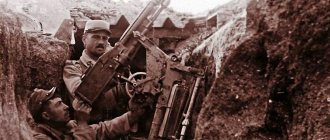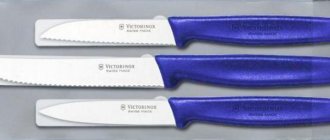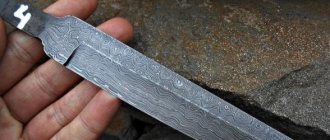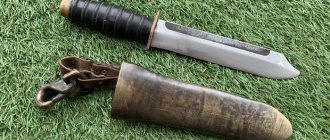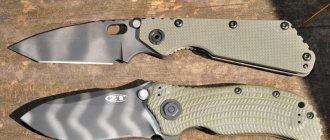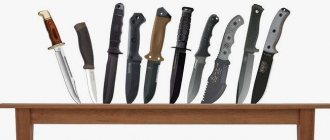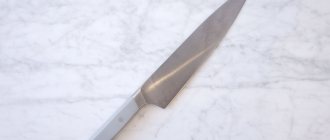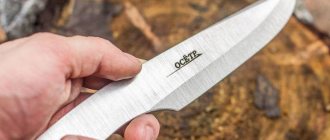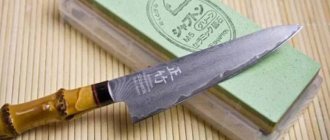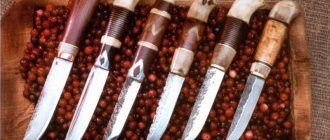One of the most popular knives in Russia is the Finnish knife, known since the times of the Russian Empire. In the 20s of the twentieth century, its popularity reached such a scale that every knife with a straight blade and similar dimensions began to be called a finka, regardless of the manufacturer. Today, real Finnish knives are highly valued all over the world for their versatility and multifunctionality. This knife is indispensable in everyday life, useful for hunting and hiking. This item will always be a welcome gift or souvenir from Finland.
The history of the creation of the knife and the appearance of its name
The Finns are considered to be the creators of the knife, although there is another version according to which blades began to be imported to Finland from the Germans through Sweden. Historians can dispute this fact for a long time, but the main thing remains indisputable - the inhabitants of the Scandinavian countries highly appreciated the Finnish woman.
For residents of a country where hunting and fishing are developed, a knife of this configuration was simply necessary. Its small size and convenient use made it very popular, first among hunters, and then among the entire population.
During the Russian Empire, the Principality of Finland was part of the state from 1809 to 1917. Before that, it belonged to Sweden. The policy of disarmament of the indigenous population was carried out regularly and had a depressing effect on the people. The 19th century was marked by the liberation movement, and the Finnish knife culture became its personification. The Finnish guys who controlled residential settlements and villages were fighters for a free life and robbers at the same time. More often these were the heirs of the owners of large farm houses. Their distinctive feature was knives with stacked handles. All other Finns, from early childhood, also always carried traditional knives.
How did a puukko utility knife turn into a gangster finca?
Before the revolution in the Russian Empire, no one considered carrying a knife as something criminal. On the contrary, Russian traditional culture assumed the constant carrying of a knife, especially among peasants. With the Bolsheviks coming to power, everything changed; in 1927, the first bans related to knives appeared. In the early 1930s, a massive campaign began to ban all knives except kitchen knives, the echoes of which resound in the minds of ordinary people even today.
In 1932-33, a series of publications appeared in which various bandits and kulaks brutally dealt with representatives of the Soviet government with knives. Finnish knives were clearly mentioned in the articles, since these were the knives most often used by professional criminals of those years.
Design features
The shape of the Finnish knife has come to us since the Bronze Age, and essentially has not changed. The traditional Finnish blade is called a puukko, which in Finnish means “equipped with a wooden handle.” Over time, various variations of the model appeared, but the main features remained constant.
The main one is efficiency in application. The length and width of the size of the Finnish knife in the drawings could be slightly modified. Main characteristics of the Finnish:
- The blade is straight, small, made of steel (Rockwell hardness 54 units), slightly longer than the length of the palm, sharpened on one side. Its dimensions of 125 x 20 x 4 mm allow the cutting part to be significantly more resistant to physical stress.
- The butt is wide, straight, in line with the blade, and has a thickening in the center - this allows it to fit more comfortably in the palm. Also withstands significant impacts.
- A distinctive feature is the heel - the unsharpened part of the blade between the guard and the handle. It allows you to control the nature of the cut by placing your index finger in a given place.
- Mounted handle, 150-200 mm long (total knife length up to 300 mm). The classic oval version of the handle is made of birch (preferably birch burl) from the Karelian Peninsula. Thanks to the mandatory wax (bee) and oil impregnation, the handle becomes more durable, does not slip, and does not cool the skin of the palm. Special indentations for the fingers - a Finnish grip - allow you to securely hold the blade in your hand. The edge of the handle has an extension (in the form of a mushroom cap), making it comfortable to hold even with mittens. The connection between the handle and blade is secured with a metal border.
- The sheath is most often made of calfskin, and there is a fastener for a belt. The mouth of the sheath is clearly adjusted to the size of the blade. Taking out the fin is convenient and quick.
Features of the shape of the knife are due to the harsh climate of the north:
- the wooden (not metal) handle can be safely taken by hand in cold weather;
- the oval, large shape of the handle is easy to feel even in a mitten;
- The slopes, brought to zero from the middle of the butt, are designed for convenient planing of wood.
Finks change over time. New decors appear:
- inserts between the blade and handle made of gold or brass;
- handle heads in the shape of various figures;
- engraving on the blade;
- various decorations of the scabbard.
How to make a binding or bolster?
To make a binding or bolster you will need a sheet of copper or brass about 3 mm thick. Bolster is much easier to make, so I will tell you right away how to make it. Cut a piece of brass or copper into a square or rectangular shape. The most difficult thing is to make a hole for the shank of the blade. The slot is cut using a file or an engraving machine. As a last resort, you can drill several holes side by side and connect them together. Then the slot in the bolster is widened using a needle file.
To make a binding you will need:
- A plate of copper or brass that needs to be shaped into a round shape;
- Matrix;
- Punch.
The matrix can be made from a piece of ¾-inch iron water pipe, the punch from a piece of fittings of suitable diameter. The round plate is annealed on fire (possibly gas), after which it is given the desired shape. The process is very labor-intensive, so it’s better not to bother with the binding.
Varieties
Classic Finnish blades are usually divided into two groups: puukko and leuku. Puukko is intended for hunters. The knife is considered the prototype of the Finnish knife; it is equally famous in Norway and Sweden. This characterizes the blade as indispensable for housework in northern climatic conditions. The Finnish puukko knife is divided into groups according to function:
- a knife with a soft bend in the spine - for manipulating wood;
- hunting;
- with a wide blade;
- short blade - for wood.
The blades are often not long, up to 100 mm. They often have gutters on the sides and slopes from the center of the butt, reduced to zero. Four generations of craftsmen living in specific areas of Finland make these high-quality blades.
Puukko have a difference in the through installation of the blade, and the front end of the handle is often reinforced with a metal bolster.
Leuku is the Finnish name for the knives of the Sami people inhabiting Lapland. They differ from puukko in their greater thickness, weight and length. They can replace small hatchets; they can easily trim stakes and split splinters. Leuku blades are similar to Chukchi and Koryak blades:
- the blade is long, large and wide;
- butt, widens towards the handle, large;
- handle at the end in the form of a mushroom - for firmly holding the blade in the hand when making a strike;
- A distinctive feature of Lapland knives is the tip on the sheath made of deer antler, for easy holding when removing from the sheath.
Leuku
Puukko
Use of traditional puukko in the Red Army
Since after several months of fighting against the Finns it became clear that it was very difficult to fight without a knife in such conditions, the soldiers began to arm themselves with captured Finns. Puukkos were especially popular during the war with Soviet mobile units of skiers, reconnaissance officers and counterintelligence officers.
However, traditional Finnish knives were not suitable for Soviet soldiers. This universal knife did not have a stop or guard, so the traditional Finnish grip was very different from the one to which the Russians were accustomed. Puukko must be held so that its handle rests on the palm, otherwise when struck, the fingers will slip onto the blade. It is for this reason that the Soviet command decided to make its own version of the Finnish rifle, intended for intelligence officers.
Modern variations
Today Finnish knives are produced by private specialists and large companies. The appearance of the blades continues to change, and decorative elements are added. More and more attention is being paid to the sheath, blade of the blade, and handle.
The most expensive blades are made by hand. There are regions where more than 150 private workshop companies produce Finnish knives with their own hands, and there are also large manufacturers who make only traditional classic Finnish knives.
Current models from Finns most often:
- stainless steel;
- with a diamond edge for sharpening;
- carbon steel, for woodworking;
Classic and new models are in demand:
- Knife “Lynx”, “Leuku”.
- Fishing - traditionally with a wooden handle. There are improved ones: rubberized, made of Teflon with a file for removing scales.
- Hunting Teflon - for cutting meat, skinning, ripping.
- A series of knives for kitchens and models for mushroom pickers.
- Exclusive models - made of Damascus steel or the “Shaman’s Tooth” model.
- Collectible versions (handmade) - with the national Finnish coat of arms or with a knob in the shape of a partridge.
Why is it considered a combat knife?
Only at the beginning of the twentieth century did Finnish knives begin to appear in Russia. Criminal elements were among the first to appreciate the new type. The small size made it possible to discreetly hide the blade behind a waist belt, in the sleeve and boot top. Every criminal considered it obligatory to purchase a Finnish car.
Later, the population of the country appreciated the advantage of the new knife over others and it was renamed the Finn. Having adopted the basic manufacturing technique and improved it, Russian gunsmiths quickly launched production of the product. Externally, the knife already looked a little different. In Russian version:
- there is a groove on the blades;
- a guard appeared - the division of the blade and handle.
In 1935, the Finnish knife became a prohibited weapon on the territory of the USSR. But the Criminal Code, by banning the finca (until 1996), only increased its value. Anyone who dared to wear a finca among criminals became an authority. In the Soviet-Finnish conflict of 1939, small squads of Finnish skiers armed with puukkos caused great damage to the Soviet military by alternating ambushes with raids on patrols at night.
But in addition to using the blade as a weapon, the blade performed many other military tasks necessary for a soldier:
- equipment for combat locations;
- production of snowshoes and stretchers;
- ammunition repair;
- cooking and preparing a place to spend the night.
The Finnish soldiers' knife was practical. It was taken out silently and was convenient in hand-to-hand combat. The razor-sharp blade cut bread perfectly and removed Soviet army sentries.
The Red Army had to accept the evidence of the successful use of the Finnish gun. And exactly one year later, the “scout” knife was approved for use in our Army. The principle of hand-to-hand combat with and against a knife was developed.
The Finnish blade remains popular in both countries today. A variety of its modifications are offered on the market. Numerous mentions of this type of knife in twentieth-century fiction gave it a reputation as a dangerous weapon for decades.
How a puukko utility knife became a bladed weapon of Finnish warriors
The second discovery of the traditional Finnish knife in Russia occurred during the Soviet-Finnish War. Since the fighting took place in the forests of Finland, the Red Army soldiers were faced with completely unfamiliar battle tactics. Finnish soldiers, most of whom were professional hunters, fought a completely atypical war for Russians. The Finns preferred to use the following tactics:
- Sniper war;
- The assault troops attacked at night;
- Reconnaissance and sabotage detachments appeared suddenly and destroyed or captured ammunition.
It was during this war that the Red Army soldiers became closely acquainted with traditional Finnish puukko knives. An interesting point is that in those years Finnish soldiers were not armed with puukko knives. The famous M-27 model, called Ukko-Pekka, appeared later and was intended for the Civil Guard forces. And the Finnish soldiers had M-27 bayonets, which were also produced by Fiskars. However, almost every Finnish soldier had a personal puukko knife, which he was used to working with since childhood.
During the Winter War, Finnish skiers, dressed in white camouflage robes, suddenly appeared in front of Red Army soldiers and shot them with submachine guns, after which the survivors were quickly and effectively finished off with puukko knives. It was then that stories began to emerge about the lethality of traditional Finnish knives with traditional Karelian birch handles. The best trophy in that war for a Russian soldier was a Finnish knife, since the Red Army in those years had no knives in service at all.
Popular manufacturers
If you want to purchase a real Finnish knife, then you need to do this directly from well-known manufacturers or private craftsmen in Finland, as well as through their direct representatives.
The most famous and oldest knife factory in Finland is Marttiini. She is over 90 years old. It is located 1,000 km from the border with Russia, in the small city of Rovaniemi. The craftsmen of this factory have glorified the Finnish knife throughout the world. There are several large stores on the territory, where there is a huge selection of Finnish guns.
The most expensive models are made of Damascus steel, their cost is from 20 to 500 euros, they have an original pattern, thanks to a different alloy of the thinnest layers of metal. They are produced in small batches of several hundred per year and are numbered. Plus, the manufacturer offers free engraving.
Worthy of attention is a rare modification of a knife with shamanic handles that make a sound when shaken. This sound, according to legend, drives away evil spirits. There are several official Marttiini stores in Russia.
List of other well-known companies producing high-end knives:
- Iisakki Järvenpää is one of the oldest Finnish knife manufacturing companies in the city of Kauhava. Once upon a time, their blades were supplied to the Russian palace. Currently, classic knives are produced for souvenirs and for export from 30 to 100 euros.
- Lapin Puukko – in the city of Tervola. The manufacturer offers inexpensive traditional knives and models for women. The handles are made of Karelian birch and plastic. Models are made to order.
- Kainuun Puukko and Roselli - offer high-quality, expensive products starting from 150 euros. They can be purchased at the Oulainen specialty store.
Each Finnish company has its own official website where you can get acquainted with the products.
Iisakki Järvenpää
Kainuun Puukko and Roselli
Lapin Puukko
The best puukko models
Currently, you can buy both traditional puukko knives and numerous replicas. On the one hand, a traditional knife looks distinctive and original, but on the other hand, you need to get used to the Finnish grip. Modern companies and private knife makers will make a knife taking into account any wishes. Handles made of ebony and other valuable types of wood are extremely popular now.
The best knives are considered to be those produced by Martini, Roselli and other famous knife brands that have been producing puukko knives for many years.
